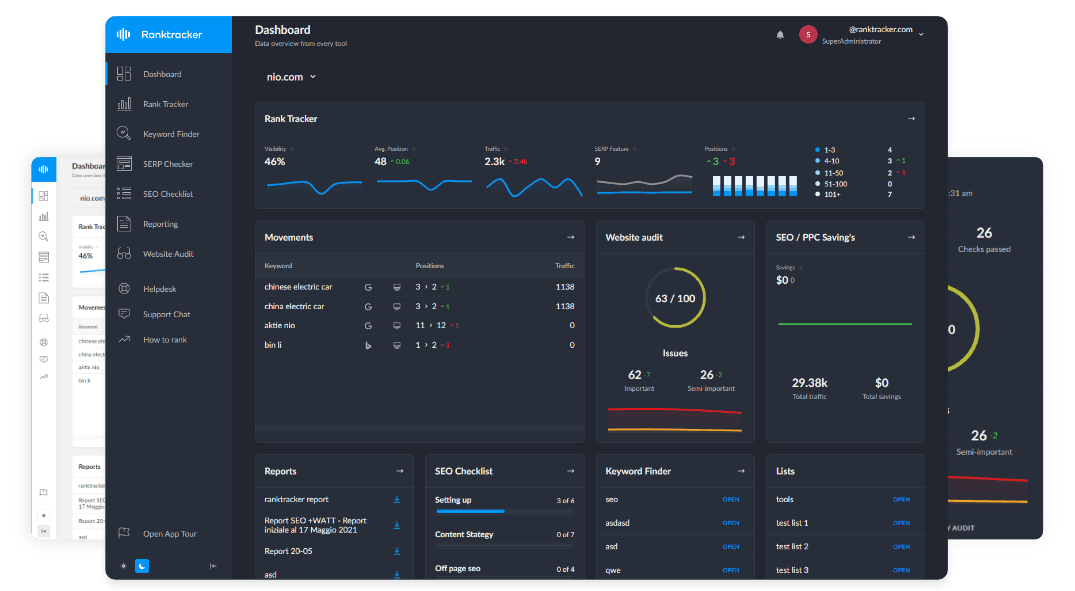Intro
In today's fast-paced digital world, website traffic has become one of the most crucial factors for determining the success of any online business or platform. Whether you're running an e-commerce site, a blog, or a business-focused landing page, the volume and quality of traffic can make or break your site’s visibility and profitability. As a result, website owners constantly seek new ways to boost their traffic, which is where traffic bots come into play.
A Traffic bot, such as those offered by services like Sparktraffic, promises to simulate human behavior by automatically visiting websites, clicking on ads, or filling out forms. The main objective? To create an illusion of higher visitor engagement and, in turn, increase perceived website popularity. But are these traffic-boosting tools the game-changers they’re made out to be, or are they more of a risky, short-term strategy? In this article, we’ll break down the pros and cons of using traffic bots, exploring the potential benefits and the serious drawbacks of relying on these automated scripts to inflate web metrics artificially.
What Are Traffic Bots?
To understand the debate surrounding traffic bots, we must first know what they are. Traffic bots are automated scripts designed to replicate human activity on websites. These bots can mimic various behaviors that an average user might perform, such as:
- Visiting multiple pages on a site
- Clicking on banner ads or sponsored content
- Completing online forms or signing up for newsletters
By simulating these activities, bots artificially inflate a website's web traffic data. This can create a false sense of popularity and engagement, which may lead to more advertisers, higher visibility, or even a stronger SEO ranking. While this might sound like a quick way to gain credibility, the long-term consequences of using such tactics can be far from favorable.
The Benefits of Using Traffic Bots
Despite the ethical questions raised by their use, some website owners find traffic bots appealing due to the immediate advantages they promise. Here’s a closer look at how they can impact your online presence:
- Improved Metrics
For those trying to build their website’s reputation quickly, traffic bots provide a fast way to boost traffic statistics. Higher visitor numbers can make your site appear more popular, credible, and authoritative, which can be particularly useful if you’re just starting or are struggling to gain traction. With more page visits, your site’s analytics will reflect higher engagement, potentially attracting organic visitors who believe the site is a popular destination.
- Increased Ad Revenue
For websites relying on ad revenue, more traffic usually means more money. Traffic bots can simulate visits to ad banners and sponsored links, increasing the number of ad impressions and clicks. This can result in a short-term boost in revenue, especially for those participating in pay-per-click (PPC) advertising models.
- Testing and Development
For developers and website owners, traffic bots can be helpful for testing. They can simulate a large volume of visits to your site, allowing you to test your website’s load capacity and identify potential performance issues. This can be particularly beneficial for high-traffic sites that must be prepared for visitor surges, such as e-commerce platforms during holiday sales or media websites covering trending topics.
- SEO Experimentation
Some SEO specialists use traffic bots to experiment with different strategies and measure their impact on search engine rankings. For instance, they might test whether certain actions—such as simulating more clicks on specific pages—could improve a website’s standing in search engine results. Although not a foolproof approach, bots can help monitor the potential effects of various SEO tactics without putting real traffic at risk.
The Drawbacks of Using Traffic Bots
While traffic bots may offer some short-term benefits, the risks and ethical concerns they raise are considerable. Let's explore some of the significant downsides of using these tools:
- Misleading Data
One of the most significant drawbacks of using traffic bots is creating misleading data. While bots can boost your traffic numbers, they do not reflect real user engagement. As a result, your analytics may show inflated visitor counts, but those visits do not translate into meaningful actions such as product purchases, newsletter signups, or customer inquiries. This can lead to poor decision-making based on inaccurate data, ultimately hindering your business's growth.
- Violation of Terms and Policies
Many ad networks and search engines have clear guidelines against using artificial traffic to inflate metrics. Google, for example, has strict policies that can result in penalties or even the complete removal of a website from search results for using traffic bots. Likewise, ad networks like Google AdSense can suspend or ban accounts that rely on inflated traffic metrics. Violating these terms can have devastating consequences, leading to lost revenue and a damaged reputation.
- Ethical Concerns
Another downside is the ethical issue of deception. Using traffic bots to inflate website traffic can be seen as dishonest or manipulative, particularly if the goal is to mislead advertisers, partners, or potential customers. Not only does this undermine the integrity of your business, but it can also damage trust with your audience and stakeholders if discovered.
- Detection and Detection Risks
In today’s digital environment, detecting fake traffic has become increasingly easier for advanced algorithms and detection tools. Traffic bots leave digital footprints that can be identified through abnormal patterns, such as unusually high bounce rates or engagement metrics that don’t match the website's overall content. Suppose search engines or ad networks detect the use of traffic bots. In that case, they may penalize or even denylist the website, rendering the bot strategy ineffective and actively harmful to your site’s standing.
Real-World Consequences of Using Traffic Bots
The real-world implications of using traffic bots go beyond misleading data and ethical concerns. If your website's metrics are artificially inflated, it can affect your overall business performance. For instance:
- E-commerce Sites: An e-commerce platform that uses traffic bots might initially appear popular, attracting genuine visitors looking to shop. However, once these visitors engage with the site and realize that the high traffic numbers don’t correspond to fundamental interactions or sales, they might leave without purchasing. This can lead to high bounce rates and lost opportunities.
- Advertisers: If advertisers discover that your site’s traffic is not genuine, they may be less inclined to invest in ads on your platform. This loss of trust can make building long-term relationships with potential advertisers difficult, ultimately damaging your site's potential for generating revenue.
- Search Engine Penalties: Traffic bots can result in search engine penalties, particularly if Google or other search engines detect unusual activity on your site. Penalties can severely affect your website’s ranking and visibility, making it harder to recover in the long run. Websites that engage in deceptive practices may struggle to regain their previous position, even after removing the bots.
Ethical Alternatives to Boost Traffic
If you want to build your online presence and grow your website’s traffic without resorting to traffic bots, here are some ethical and effective strategies:
- Focus on High-Quality Content
Content is the backbone of any successful website. By providing valuable, informative, and engaging content, you’ll naturally attract organic traffic from visitors interested in what you offer. Whether through blog posts, tutorials, videos, or case studies, high-quality content will always resonate with your audience.
- Optimize for SEO
Search engine optimization (SEO) is the most sustainable and reliable way to increase organic traffic. By optimizing your website’s structure, content, and metadata, you can improve its visibility on search engines like Google. This includes using the right keywords, optimizing meta tags, building quality backlinks, and ensuring your site is mobile-friendly.
- Engage on Social Media
Social media is a powerful tool for driving traffic to your website. Regularly sharing your content and engaging with your audience can build a community around your brand. Platforms like Facebook, Twitter, LinkedIn, and Instagram are perfect for sharing blog posts, running promotions, and connecting with potential customers.
- Build an Email List
Building an email list is an excellent way to drive repeat traffic to your website. By sending regular newsletters or updates to your subscribers, you can encourage them to revisit your site and stay engaged with your brand. Offering exclusive deals or content can incentivize users to sign up for your email list.
- Collaborate with Influencers
Partnering with influencers or other brands can expose your website to a broader audience. By collaborating on content, guest posts, or co-branded campaigns, you can attract more visitors and increase your website’s visibility.
- Enhance User Experience
A fast, mobile-friendly website and easy navigation will attract and retain more visitors. Ensuring your website provides a seamless user experience is key to encouraging users to return and recommend your site to others.
FAQ About Traffic Bots
- Are traffic bots legal to use?
Traffic bots themselves are not illegal, but using them to artificially inflate traffic can violate the terms of service for ad networks, search engines, and other online platforms. If you’re caught violating these terms, you could face penalties such as account suspension or being blacklisted.
- Can traffic bots improve my SEO?
While traffic bots may temporarily increase your site's traffic numbers, they do not contribute to real engagement or improve your SEO ranking in the long term. Search engines like Google prioritize genuine user engagement and can penalize sites that use artificial traffic manipulation.
- Do traffic bots affect ad revenue?
Yes, traffic bots can increase the number of impressions and clicks on ads, but these actions do not represent real users. Over time, this can lead to wasted ad spend and reduced effectiveness in attracting genuine advertisers to your site.
- What are the consequences of using traffic bots?
The most significant consequence of using traffic bots is the potential for search engine and advertising network detection. This can lead to penalties, reduced visibility, and a loss of credibility with advertisers and users alike.
Opinion: Buying Links and Traffic Isn't Always Bad
In an ideal world, SEO strategies would be built entirely around organic growth and high-quality content. However, many businesses face intense competition and find themselves needing to take more proactive measures to stay afloat. Buying links or driving traffic through tools like bots may seem like a shortcut, but sometimes, it's a necessary evil to maintain momentum, especially in highly competitive industries.
Buying links, for instance, is not inherently "bad." When done correctly, it can be a legitimate tactic by acquiring high-quality backlinks from relevant and authoritative sites. Similarly, when used in moderation, driving up traffic through paid methods or bots can provide the short-term boost needed to attract real visitors. After all, Google Ads, which are often seen as the go-to solution for boosting site traffic, can sometimes come out more expensive and less effective in the short term compared to alternative methods. The key is to balance these tactics carefully and ensure that they do not violate the terms of service or harm your site’s reputation long-term.
Conclusion
While traffic bots like Sparktraffic may seem like an appealing shortcut to boost web traffic, their use comes with significant ethical, practical, and long-term risks. The drawbacks often outweigh any immediate benefits, from misleading data to potential penalties from search engines and advertisers. Instead of relying on bots, focusing on organic methods such as creating quality content, optimizing for SEO, and engaging with your audience will lead to sustainable growth and a more authentic online presence.
Deciding whether to use traffic bots depends on a website owner’s goals and values. However, for those seeking long-term success, investing in genuine traffic growth strategies will yield far better results. The key to building a reputable online presence is not shortcuts but consistent, value-driven efforts that engage real users and foster trust.

